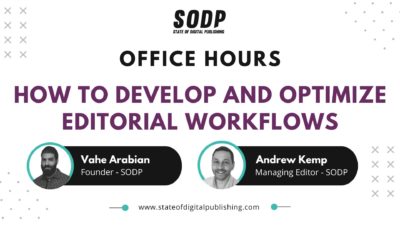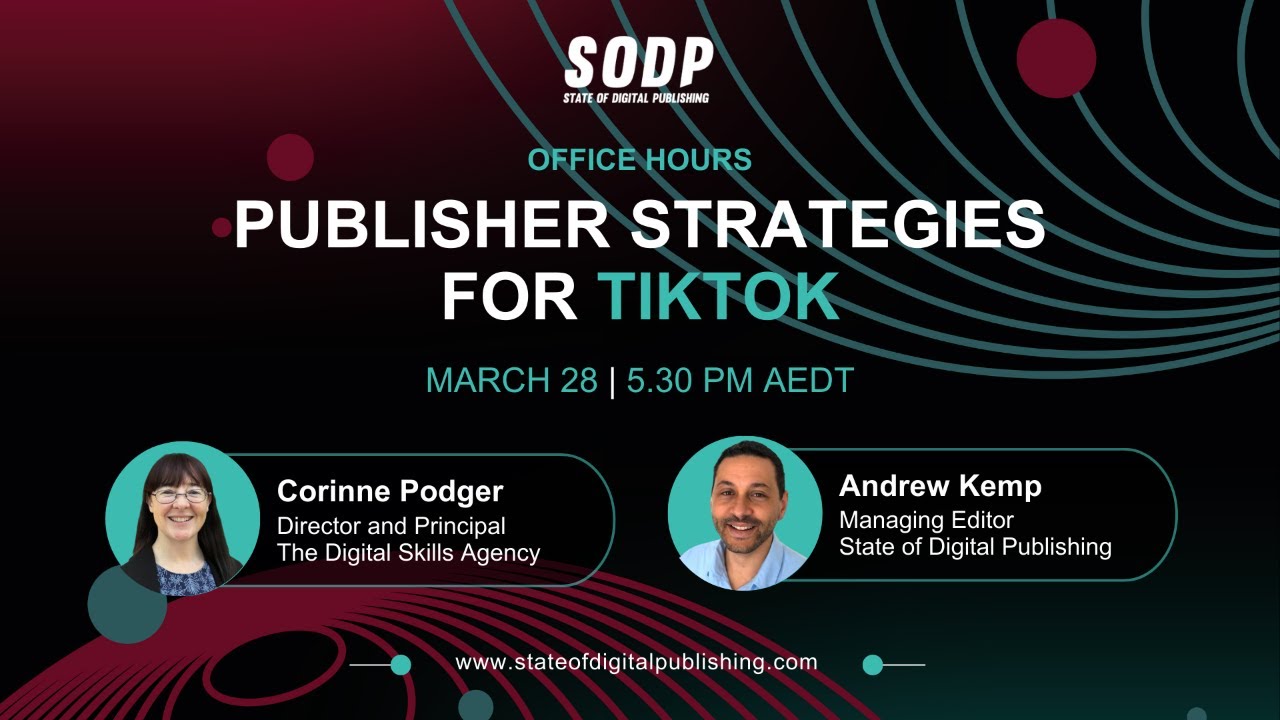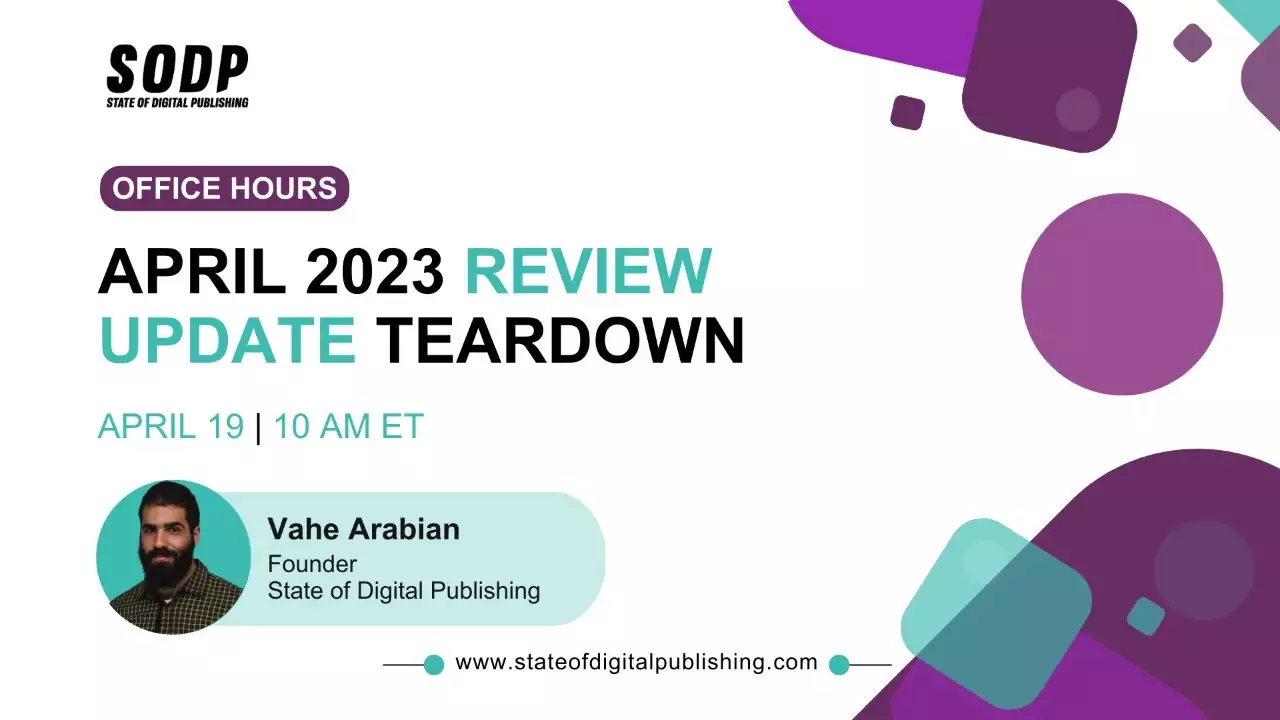Office Hours
Join Vahe Arabian, founder of State of Digital Publishing (SODP), and Andrew Kemp, managing editor of SODP, as they discuss the company’s editorial workflow, how the team copes with common challenges daily and learn how to build an effective editorial workflow.
About SODP
As a hybrid publisher and consultancy for publishing brands, State of Digital Publishing (SODP) helps publishers build sustainable business models for long-term growth.
SODP’s social memberships grant access to our one-on-one support, insights and data, as well as our Content Cluster Strategy Toolkit that provides step-by-step instruction on how to develop content pillars.
You can become a member today at $39 per month or secure a 30% discount on the monthly price with a yearly subscription. Get access to all webinar recordings, exclusive industry insights, and more with an SODP membership.
Agenda
- SODP’s editorial process
- How to develop an editorial process
- Content ops stack
- Defining user roles
- WordPress workflow
- Plan-create-promote workflow
The SODP Editorial Process
An editorial workflow doesn’t need to be super flash — a pad of paper and a pen can be enough to get things done.
While the latest and greatest tools can certainly help, they’re not always essential to content creation. However, what is vital is documenting the processes and applications used in the creation process.
Only then will you have a clear understanding of how each step and process interacts with, supports or undermines the system. Gaining a foundational understanding of your editorial workflow then opens the door to introducing more tools that can profoundly impact efficiency.
Tools and Platforms
We’ve been using Nifty as our project management tool for quite some time. Nifty is a great tool for capturing all the details about a specific project. Unfortunately, this granularity can sometimes become overwhelming, making it more challenging to get a bird’s eye view of what’s going on with content projects.
Therefore, we added a one-page editorial Google Sheet to our process to get a quick snapshot of where projects are at any given time. The sheet contains a link to each project in Nifty, which gives better control over creating and assigning sub-tasks and tracking deadlines.
We work with a lot of freelancers and have a very strong set of standards. When you’re working with freelancers, it’s essential that you’re able to identify when somebody will work out and when they won’t and then swiftly take action when quality becomes an issue. This means you also need to establish a pipeline to expand your writing pool.
We use a platform called Workello to hire writers. It allows us to have a bird’s eye view of the hiring process, including the number of applicants, their professional links, etc. With this tool, there’s no need to field emails from each applicant as you try to find the most suitable writer for the job.
Workello allows for candidate management — testing, rejection and hiring — all in one place. Having a system in place to quickly scale up and down recruitment efforts allows the ediors to be a lot stricter with their existing writers.
Plagiarism (direct or semantic), sloppy work and a lack of technical capability will force us to sever ties with a writer.
The Briefing
The briefing process can be quite straightforward if you have an established team of writers who understand what you’re looking for. However, if you’re striving to improve the core competency of your writing team, then communication becomes vital.
At SODP, we created project templates that allow us to quickly compile style guides, project descriptions and content expectations in every brief we send to the writing team. This will enable writers to understand the writing guidelines prior to starting a project.
When it comes to building a brief, expecting writers to be able to deliver a 3,000-word piece from 30 words of instruction is a recipe for disaster, regardless of the writer’s expertise. Instead, a good brief needs to be clear and have the expectations properly defined.
To that end, we create a skeletal structure equal in length to roughly 10% of the project’s target word count.
For instance, for a 3,000-word project, we create a 300-word brief containing bullet points, directions and rough headers. It gives the writers an idea of the ground they need to cover.
Creating a skeletal structure involves a few different SODP team members. First, the SEO team identifies the topics and keywords before drafting a rough brief using reference material it uncovered in its research. The editorial team is responsible for making sure the instructions are clear as well as adding further instructions as necessary. These can include comments about how much weight and significance certain sections should have.
Assembling the Team
Looking for ideal writers is an ongoing process at SODP. Hiring the wrong person can create drag, as instilling the company’s culture and mission becomes much harder.
Therefore, we look for reasons not to hire rather than for reasons to hire. We rely on a few hiring boards and platforms to connect with new writers, with our VA looking after the time-consuming process of posting jobs, etc.
In the meantime, we have also launched an internship program, partnering with two universities.
Organizing the Process
Editorial workflows run in cycles. The process is never complete and there’s always a better way of doing things, which you might not always be able to see at first.
As such, you should be working with the rest of your team to review how they approach the workflow for better ways of doing things.
Look for better ways to streamline your content pipeline either through a better program, tool or process.
Everyone has a process for every action within your company, whether they’re aware of it or not. Documenting and centralizing the company’s knowledge base is the first step toward developing efficient processes. Once a process has been drafted, it can then be presented to your colleagues for consultation and this feedback needs to be reviewed, implemented or rejected before the process is rolled out.
Our process involves templatizing for content, conducting on-the-fly research, developing content pillars and clusters, planning for content and booking the writers, evolving the process, recruiting and delegating.
Various tools make our processes efficient, and we use quite a few. For instance, Loom helps us provide proper feedback to our writers, and Surfer SEO makes it a lot more practical for writers to comply with the SEO standards that we’re looking for.
Defining User Roles
Building a process for smooth operation requires a perfect definition of roles and responsibilities.
Clearly defining the roles also removes any ambiguity staff responsibilities during the creation lifecycle. Doing so doesn’t just make the delegation process simpler but also helps identify bottlenecks and weaknesses.
An example of this is working freelancers. It’s rare to accurately assess a writer’s capabilities just from looking at their first work. They work for many employers and might not always deliver the task on time if you fail to define the extent of their obligations.
WordPress Workflow
If you’re using WordPress or a similar CMS, you can use publishing plugins that help you properly define roles and responsibilities.
For example, an administrator can access all the plugins and all the content blocks that you can update. This role is mostly limited to top-level team members, such as the editor-in-chief.
Similarly, an editor will have access to all the other features except the ability to configure plug-ins and writers should be able to create and upload the materials and receive feedback.
Some plugins to consider for WordPress are Surfer SEO, Yoast and Rank Math. You can also find alternatives, such as MarketMuse instead of Surfer SEO. Be sure to test the tools before using them. As far as the SODP team is concerned, we’re happy with what Surfer SEO offers.
A smooth workflow can help writers, editors and SEO understand the process better. This will help in effective task execution.
QA Session
How do you know when you’re using too many tools and plugins?
Vahe Arabian:
“You use tools and plugins for a few important things, such as having a detailed view of all your processes and improving the efficiencies of the SOP. When it comes to deciding what number of tools and plugins to use, you need to understand why you need them in the first place.
Some teams use tools like Airtable and monday.com while some don’t. Even a single platform can help you monitor the workflow if you work on it correctly. “
Andrew Kemp:
“There’s nothing wrong with using traditional tools such as pen and paper as long as you’re comfortable with it. However, if you use Google Sheets, for example, it comes with a lot of benefits. You won’t lose your documents, and you can access your files easily, etc.
Now, if you’re planning to shift your work from G-sheet to Airtable, there can be a lot of questions about how Airtable makes the process better or how much it costs.
In terms of editorial workflows, I won’t look at a tool’s every feature, because software is supposed to help with a definitive need. In order to get the most out of a program, you have to study the program daily and invest time in it.
Content from our partners
At the end of the day, it’s about figuring out if your new tool gives you an immediate return on your investment or if it immediately contributes to a more streamlined workflow.”
Talking about the type of writers you engage with, what is your process of working with writers with the right potential?
Vahe:
“Writers have to start their career from somewhere, at some point. We work with all types of writers and don’t engage new ones in topics or content that’s too technical or difficult for them to grasp. Nevertheless, they have to have the right capacity to do the job.
We want something that’s on par with what the audience looks for. There’s an opportunity cost if Andrew or I allocate time to research and create the content and then, later, edit it. It is actually beneficial to get multiple perspectives on the content to get a stronger piece out for our client or for our publication, even if the writer doesn’t have high-level expertise on the subject matter.”
Andrew:
“When looking for writers, you can learn a great deal from someone’s failures during the testing phase. We look for a writer’s potential. Since our writers will write on a broad spectrum of topics, they won’t have the subject expertise we might be looking for.
It’s also about analyzing the work that they have submitted and figuring out whether the writer is worth the investment it’ll take to upskill them. It’s really important to be able to identify that quickly, because if you don’t, you’re going to spend a lot of time giving writers feedback, and they’re never going to be able to process it.”
How do you decide what task you’re going to give to a particular writer, and how do you make it work?
Andrew:
“It comes down to identifying the writers’ styles, strengths and weaknesses. For example, some writers produce great conversational pieces while others excel at stats-driven articles. Conversational writers can be great at creating how-to articles.
It’s all about finding the correct writer with the right strength. If you can’t find the one with the strength in a particular field, then it comes down to finding a writer with the fewest weakness. In that case, you should be much more mindful while putting together your brief.”
Vahe:
“The other thing to add is to focus on what you want to prioritize. You have to plan a lot more in advance, so writers will be able to deliver your piece on time, and at the same time, you should have a backup in case something happens. You should always think of contingencies while you’re busy executing your content strategy.”
Watch past and future episodes on our YouTube channel and website with detailed notes. Follow us on Facebook, Twitter, and join our community groups.












